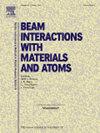Probing the synergistic impacts of different lead halides in MoO3-Borobismuthate glass systems for improved radiation-blocking and rigidity features
IF 1.4
3区 物理与天体物理
Q3 INSTRUMENTS & INSTRUMENTATION
Nuclear Instruments & Methods in Physics Research Section B-beam Interactions With Materials and Atoms
Pub Date : 2025-04-23
DOI:10.1016/j.nimb.2025.165708
引用次数: 0
Abstract
The work explores the effect of three lead halides, PbX2 (X = F, Cl, Br), on the radiation-shielding and mechanical properties of Bi2O3-MoO3-B2O3 glasses. These high-density glasses may be potential candidates for radiation-based technologies. The analysis of the results shows that in the photon energy ranges of 0.015–15 MeV, the PbBr2-rich samples with 20 mol% present high shielding parameters such as linear attenuation coefficient (LAC = 468 cm−1), mass attenuation coefficient (MAC = 95.6 cm2/g) at 0.015 MeV, effective atomic number (Zeff = 88.5), and electron density (Neff = 8.96 electron/cm3) at 0.1 MeV. Furthermore, the increase in the concentrations of PbX2, particularly in the glass containing 20 mol% of PbBr2, presents a good correlation between density and enhanced cross-link density. This relationship reflects an increment in the calculated elastic moduli through two theoretical models, indicating improved mechanical properties by incorporating various concentrations of PbX2 with adjustments based on halide type.
探索不同卤化铅对moo3 -硼铋酸盐玻璃系统的协同影响,以改善辐射阻隔和刚性特性
研究了三种卤化铅PbX2 (X = F, Cl, Br)对Bi2O3-MoO3-B2O3玻璃的辐射屏蔽和力学性能的影响。这些高密度玻璃可能是基于辐射的技术的潜在候选者。分析结果表明,在光子能量为0.015 ~ 15 MeV的范围内,含20 mol%的富pbbr2样品在0.015 MeV时具有较高的屏蔽参数,如线性衰减系数(LAC = 468 cm−1)、质量衰减系数(MAC = 95.6 cm2/g)、有效原子数(Zeff = 88.5)和电子密度(Neff = 8.96电子/cm3)。此外,PbX2浓度的增加,特别是在含有20 mol% PbBr2的玻璃中,在密度和增强的交联密度之间表现出良好的相关性。这种关系反映了通过两个理论模型计算出的弹性模量的增加,表明加入不同浓度的PbX2并根据卤化物类型进行调整可以改善力学性能。
本文章由计算机程序翻译,如有差异,请以英文原文为准。
求助全文
约1分钟内获得全文
求助全文
来源期刊
CiteScore
2.80
自引率
7.70%
发文量
231
审稿时长
1.9 months
期刊介绍:
Section B of Nuclear Instruments and Methods in Physics Research covers all aspects of the interaction of energetic beams with atoms, molecules and aggregate forms of matter. This includes ion beam analysis and ion beam modification of materials as well as basic data of importance for these studies. Topics of general interest include: atomic collisions in solids, particle channelling, all aspects of collision cascades, the modification of materials by energetic beams, ion implantation, irradiation - induced changes in materials, the physics and chemistry of beam interactions and the analysis of materials by all forms of energetic radiation. Modification by ion, laser and electron beams for the study of electronic materials, metals, ceramics, insulators, polymers and other important and new materials systems are included. Related studies, such as the application of ion beam analysis to biological, archaeological and geological samples as well as applications to solve problems in planetary science are also welcome. Energetic beams of interest include atomic and molecular ions, neutrons, positrons and muons, plasmas directed at surfaces, electron and photon beams, including laser treated surfaces and studies of solids by photon radiation from rotating anodes, synchrotrons, etc. In addition, the interaction between various forms of radiation and radiation-induced deposition processes are relevant.

 求助内容:
求助内容: 应助结果提醒方式:
应助结果提醒方式:


